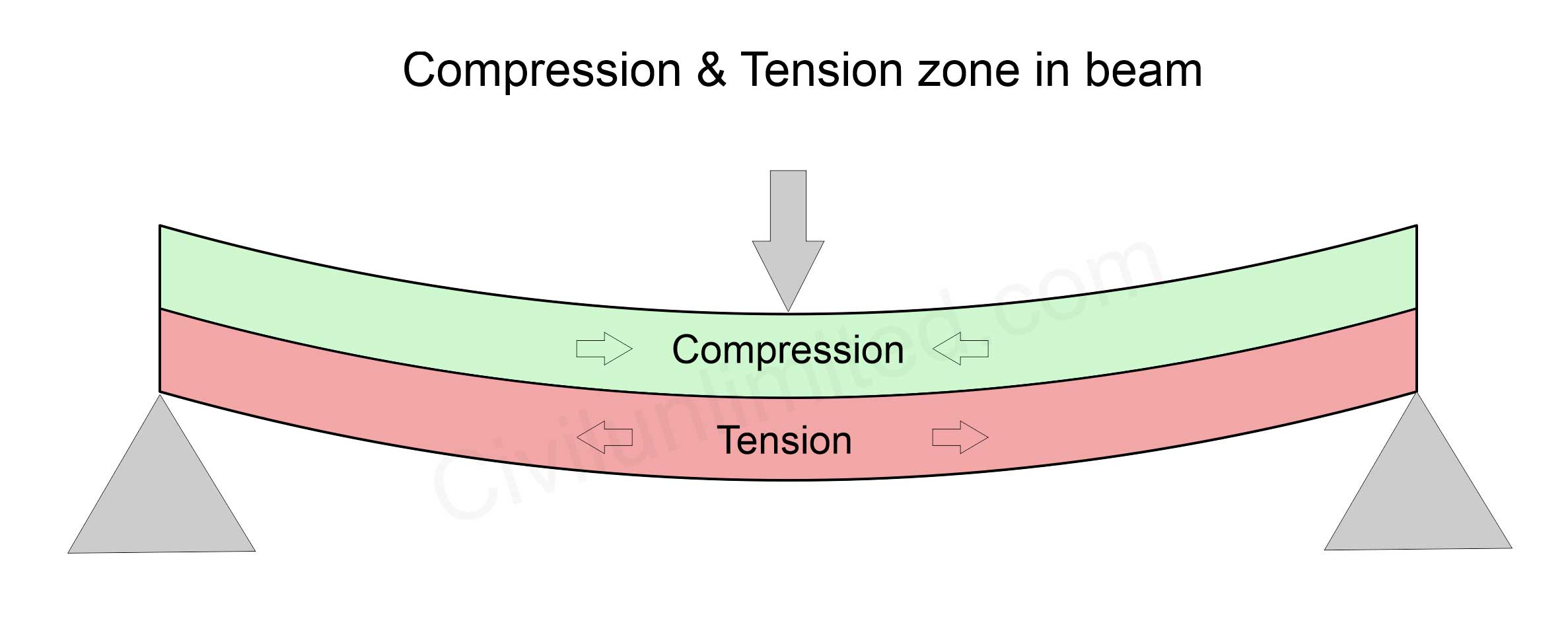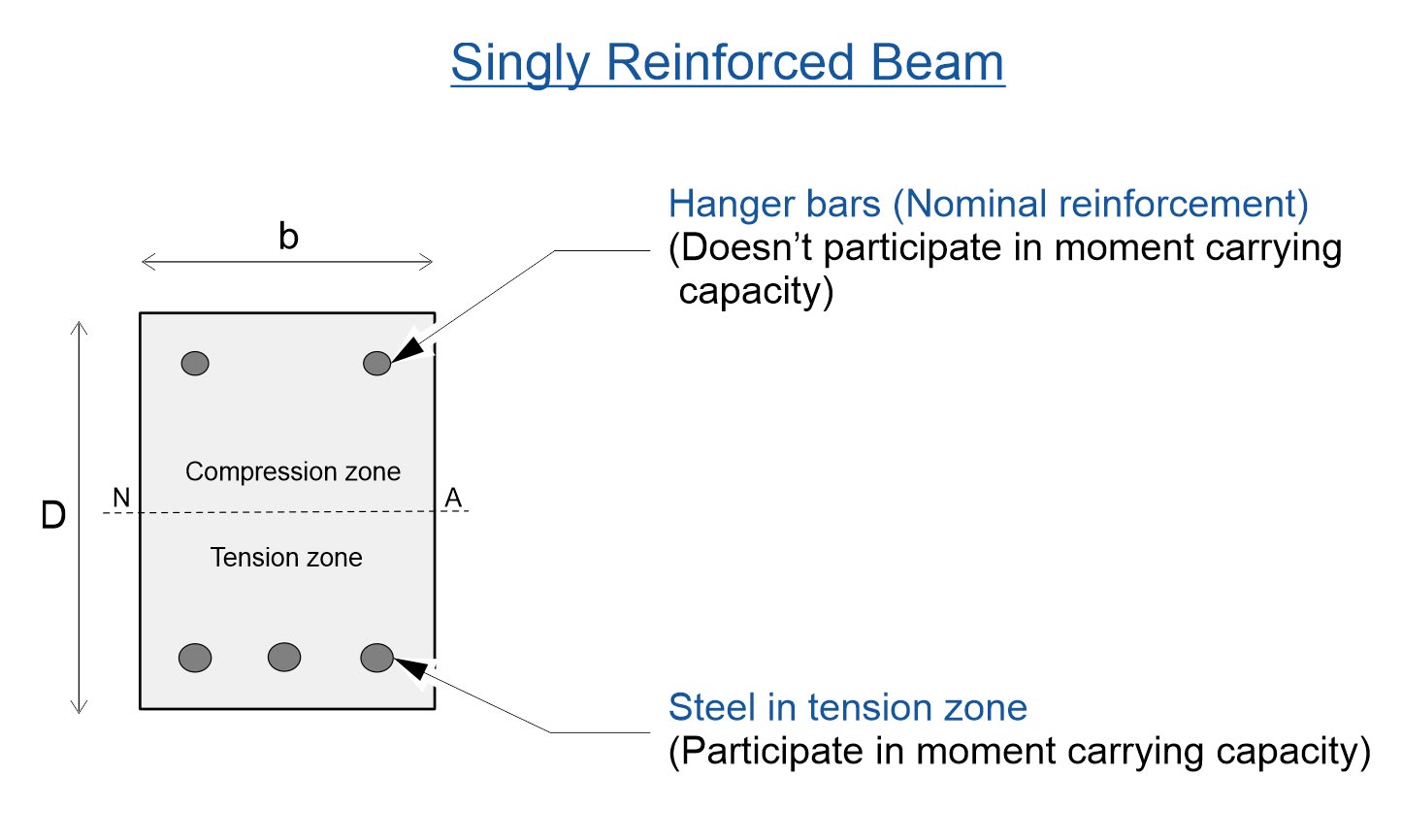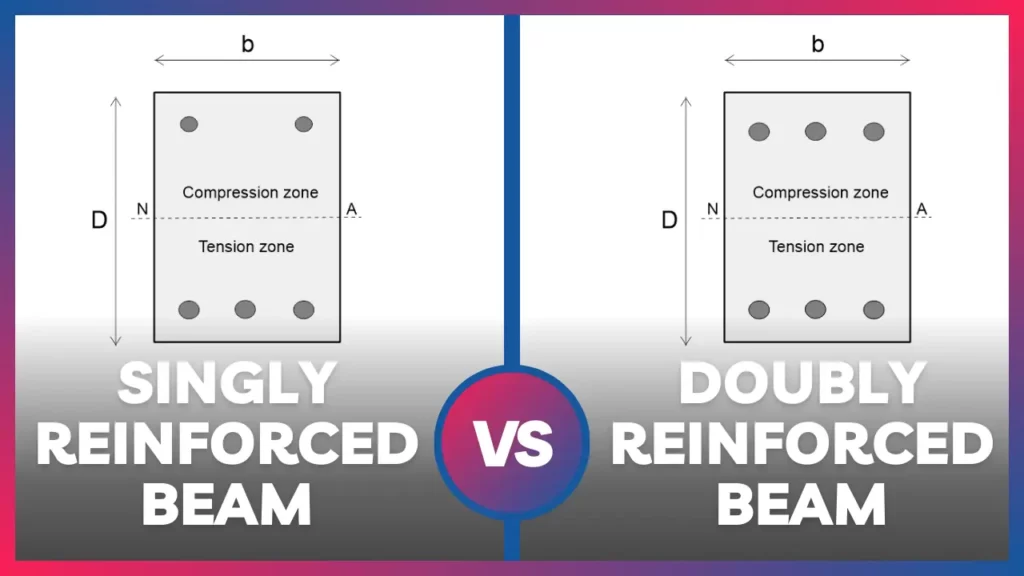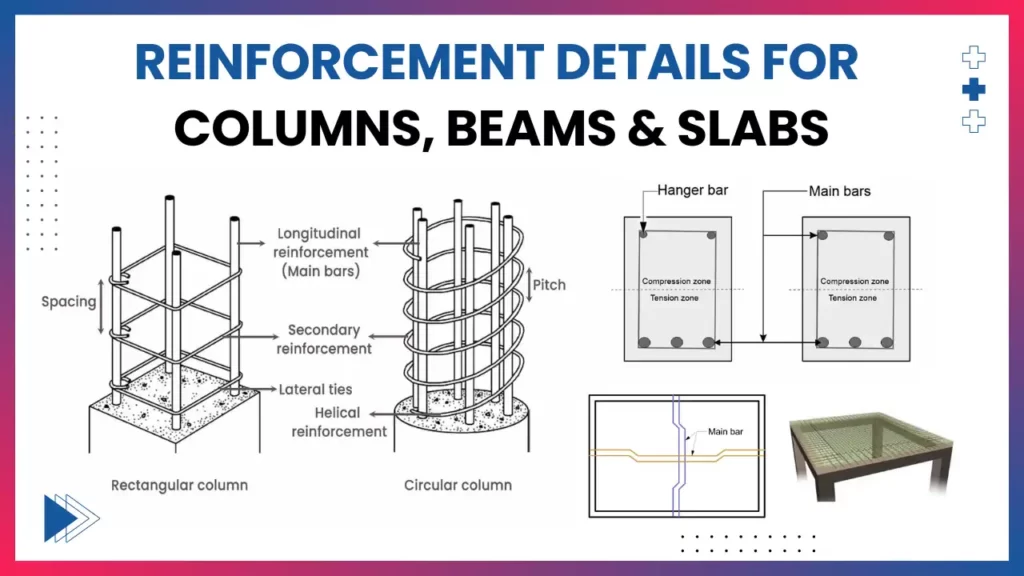To understand the difference between a singly reinforced beam and a doubly reinforced beam better, let’s review some fundamental concepts.
What is a beam?
A beam is a structural element that is used to support loads and transfer them along their length to their supports, which may be walls, columns, or any other supporting member.
Beams are typically horizontal linear members and they are commonly found in buildings, bridges, water tanks, and various structures.

Types of beams
Beams can be classified according to their,
- Supporting conditions
- Shapes
- Materials etc.
1) Supporting conditions
Basically, there are three different types of end supports commonly used in structural analysis. They are pinned support, roller support, and a fixed support.
These ends support are classified based on their degree of freedom and reaction provided. The following image clearly depicts their difference.

Based on the supporting conditions, the beams are classified as,
a) Simply supported beam – This is a beam supported at its ends typically with pinned support or roller supports. These supports allow the beam to rotate at their supports. It is typically used in bridges, roof beams, etc.
b) Cantilever beam –One end of the beam is fixed and the other end is free. These beams are generally used in structures like sunshades, canopies, balconies, etc.
c) Fixed-beam – A fixed beam is supported at both ends with the help of fixed supports. It restrained all the movements and moments at the support. These beams are typically used in the frames of multistorey buildings.
2) Shapes
Beams can also be available in different shapes such as,
- Rectangular
- I shape
- T shape
- L shape
- H shape
- Box shape etc.
3) Materials
Beams can also be made up of various materials like,
- Steel
- Wood
- Reinforced concrete
- Composite materials
The selection of materials depends on several factors like required strength, environmental conditions, etc.
How does the beam respond to loading?
When a beam is subjected to loading, it responds by experiencing bending and creating internal stress resultants (Bending moment and shear force).
When a simply supported beam is subjected to transverse loading, it experiences bending along its length.
The upper surface of the beam undergoes compression, while the lower surface of the beam undergoes tension. This results in the formation of a bending moment within the beam which is used to resist the external loading.

Since the beam is subjected to bending with both tension and compression forces, it is commonly referred to as a flexural member.
We know that concrete is good at taking compression loads but it is weak at taking the tension forces. Hence we have to introduce a material that is good at taking the tension forces in the tension zone to reinforce the concrete. Of course, the suitable material for that job is Steel reinforcement!
Based on the arrangement of steel reinforcement within the beam’s section, the beam is classified into a singly reinforced beam and a doubly reinforced beam.
What is a Singly reinforced beam?
The beam that is longitudinally reinforced only in the tension zone is known as a singly reinforced beam.
In these beams, the ultimate bending moment and the tension that is created due to bending are carried by the steel reinforcement, while the compression is carried by the concrete.
So, the singly reinforced beam is designed to resist the effect of external load only with the help of reinforcement bars in the tension zone of the beam.
Practically, we can’t provide reinforcements only in the tension zone because we need to provide stirrups to resist the shear developed in the beam.
Therefore, some minimum reinforcement bars, also called Nominal bars are provided in the compression zone to tie up the stirrups. These rebars don’t participate in the moment carrying capacity of the beam, it is provided only to hang the stirrups, hence the reinforcement bars that are provided in the compression zone of the beam are also called as hanger bars.

Suitability: Singly reinforced beams are commonly used in residential buildings, small-span structures, and situations with relatively lower loads.
What is a Doubly reinforced beam?
The beam that is longitudinally reinforced both in the compression and tension zone is known as a doubly reinforced beam.
In Doubly reinforced beams, the steel reinforcement provided in both the tension and compression zone participates at the moment carrying capacity of the beam.

Suitabilities:
1) When the cross-section of the beam (b x d) is restricted due to architectural reasons, then the doubly reinforced beam is used
2) If the bending moment in the structures changes like a continuous beam, then the doubly reinforced beam is adopted.
3) Doubly reinforced beam is used when the beam has some moving loads.
4) Commonly used in high-rise structures, bridges, and industrial structures.
When to use which type of beam?
In order to determine the appropriate beam for a given situation, we need to compare two key parameters.
The first one is the actual bending moment experienced by the beam (Mu) and the second one is the maximum allowable bending moment of the beam (Mulimit).
The concrete formula to find the maximum allowable bending moment of the beam is Mulimit = Q.bd2,
Where,
Q = Moment of coefficient resistance
b = Width of the beam
d = Effective depth of the beam.
There are two possible cases here,
i) Mu < Mulimit
In this case, when the actual bending moment (Mu) experienced by the beam is less than the maximum moment of resistance (Mulimit) offered by the concrete in the compression zone, it signifies that the provided concrete in the compression zone is sufficient to withstand the developed bending moment.
As a result, there is no requirement for steel reinforcement in the compression zone. Therefore, a singly reinforced beam is adequate for the structural design in this scenario.
ii) Mu > Mulimit
In this case, when the actual bending moment (Mu) experienced by the beam is more than the maximum moment of resistance (Mulimit) offered by the concrete in the compression zone, it signifies that the provided concrete in the compression zone is not sufficient to withstand the developed bending moment.
So, in this situation, we are faced with two options:
a) Increasing the cross-section of the compressive zone concrete, which is not a favorable solution from both economic and aesthetic perspectives.
b) The most viable choice is to introduce steel reinforcement in the compression zone of the beam. This additional reinforcement is necessary to support the extra bending moment that the concrete alone cannot carry. Consequently, a doubly reinforced beam is the appropriate solution in this scenario.
Difference between the Singly reinforced beam and Doubly reinforced beam
Let’s summarize the concepts that we learned in the following table.
| S.No | Singly reinforced beam | Doubly reinforced beam |
|---|---|---|
| 1 | Reinforcement bars provided only in the tension zone | Reinforcement bars are provided in both tension and compression zone |
| 2 | Steel bars in the compression zone don’t participate in a moment carrying capacity | Steel bars in the compression zone participate in a moment carrying capacity |
| 3 | Concrete in the compression zone is sufficient to resist bending moment | Concrete in the compression zone is inadequate to resist bending moment, requiring additional reinforcements |
| 4 | Used in situations where the load is minimum | Used in situations where there are constraints about the cross-section, changing bending moments, and for structures with moving loads |
| 5 | Commonly used in residential buildings, small-span structures | Commonly used in High-rise buildings, bridges, industrial structures |
Hope you understand everything you need to know about the singly reinforced beam and the doubly reinforced beam. Your feedback and comments are valuable to us, so feel free to share your thoughts in the comment section.
Read more:




Pingback: Complete Reinforcement Details For Columns, Beams, And Slabs | Civilunlimited.com
I need a full notes on high way technology, with questions and answers including videos